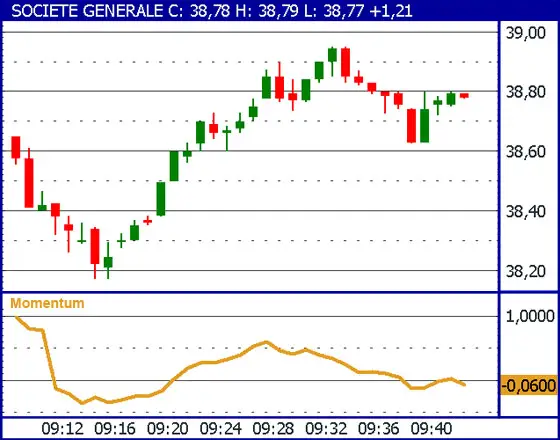Momentum Stock Trading Strategy in 5 Easy Steps
Momentum stock trading strategy focuses on stocks that are moving significantly in one direction on high volume offering traders potential for significant profit.
Momentum stock trading is a day trading strategy, where traders focus on stocks that are moving significantly in one direction on high volume. Momentum traders may hold their positions for a few minutes, a couple of hours or even the entire trading day, depending on how quickly the stock moves and when it changes direction.
Implementation of Momentum Stock Trading Strategy
Step 1: Getting Information Before the Market Opens and Building a Watch List
A momentum stock trading strategy requires you to turn on computer about an hour before the market open and start gathering overnight broad economic and financial information and focusing on stocks with new trading alerts based on earnings or analyst recommendations and stocks releasing news. These are stocks that are rumored to be in play and are anticipated to provide the most significant price movements on high volume for that trading day.
Another important task to do in the first step of momentum stock trading is to check morning equity options pages, where you should look for stocks with significant increases of volume in calls. Any increase in calls written is an important indication that a price increase or decrease above or below the option premium is expected to occur.
The result of premarket activities in momentum stock trading strategy is a initial list of stocks, which could move the markets that day.
Step 2: Watching Carefully the Market Opening Session and Narrowing the Watch List
Once the market opens, you should watch the initial list of stocks in relation to the rest of the market: are stocks on the list going up when the market goes down? Are they significantly increasing in price in relation to the rest of the market? Are they behaving consistently with your expectations based on your pre-market assessment?
You should then narrow your watch list to include only the strongest stocks: the stocks that are increasing more rapidly on higher volume than the rest of the market, the stocks that are trading contrary to the market and the stocks whose movements are clearly being propelled by external factors.
Step 3: Analyzing the Charts and Looking for a Breakout

Once these key stocks are identified, you should analyze them further by examining their charts. The primary technical indicator of interest is the momentum indicator, which is an oscillator measuring a speed and strength of a price movement, by comparing the most recent closing price to a previous closing price.
The momentum indicator is usually displayed as a single line, on its own chart, separate from the price bars. When the momentum indicator crosses the zero line upward and is above 0 (zero), the price has upwards momentum which is a signal to buy; when the momentum indicator crosses the zero line downward and is below 0 (zero) the price has downwards momentum which is a signal to sell. The momentum indicator can be used on its own, or as part of a larger trading system.
At the same time as watching the momentum chart, you should also watch the Level 2 (depth of the market), looking for evidence of a push, where bids start to line up and offers start to disappear.
Step 4: Putting the Finger on the Buy/Sell Button and Entering Position
When you believe you have identified a breakout, you do not necessarily need to jump immediately into the stock. You should not be worried about missing the first one or two breakout ticks, but you should put your hand on the buy trigger (or sell trigger in the case of a short sale, but a short sale must be done on an uptick) for one of the next momentum periods. Then you finally enter the position.
Step 5: Looking for Saturation Point and Closing the Position
Once you have entered the position, the adrenalin will pump you up while looking at the screen. Will the stock continue to move strongly in the direction of the momentum line? Or will it immediately change course, proving the momentum chart wrong and perhaps pointing to a trap set by the market maker? Or will the breakout fizzle quickly, providing some limited upside but not sufficient profit to make the trade worthwhile?
No matter what will happen, you should be looking for a saturation point, where orders start piling up on the offer and bidding slows or thins at the market price a few levels back on the Level 2 screen. The saturation point does not mean the momentum will end immediately, but it may be a sign that the top is near. So you should sell your position (or covers your position in the case of a short sale) and take your profits or loss and move on to the next stock on his list.
It should be noted that in the event of a breakout gone wrong, where a stock immediately turns direction and moves against your wishes, you should not hope for yet another reversal to make the stock go your way, but instead you should immediately cut your losses and sell (or cover) your position. It is often a far better strategy to take a small loss early after a bad trade than to hope for a reversal later in the day. Be aware, that even experienced traders have bad trades that result in losses; it will not happen only to you.
Major Risks of Momentum Stock Trading
Momentum stock trading is carrying some risks that can easily destroy even the most disciplined and knowledgeable trader:
- Jumping into a position too soon, before a momentum move is confirmed.
- Closing the position too late, after saturation has been reached.
- Failing to keep eyes on the screen, missing changing trends, reversals or signs of news that take the market by surprise.
- Keeping a position open overnight. Stocks are particularly susceptible to external factors occurring after the close of that day's trading - these factors could cause radically different prices and patterns the next day.
- Failing to act quickly to close a bad position, thereby riding the momentum train the wrong way down the tracks.
However, momentum stock trading also offers potential for significant profit since there is rarely any factor inside or outside the market that drives a stock as powerfully as momentum. With a proper understanding of the technique, sufficient knowledge of the risks, and willingness to take an occasional loss, momentum trading offers an appealing choice for traders.
Written by: Goran Dolenc
Do you find this content useful? Like! Tweet! Recommend! Share!
Back from Momentum Stock Trading to Stock Market Trade
Back from Momentum Stock Trading to Best Online Trading Site for Beginners home page







